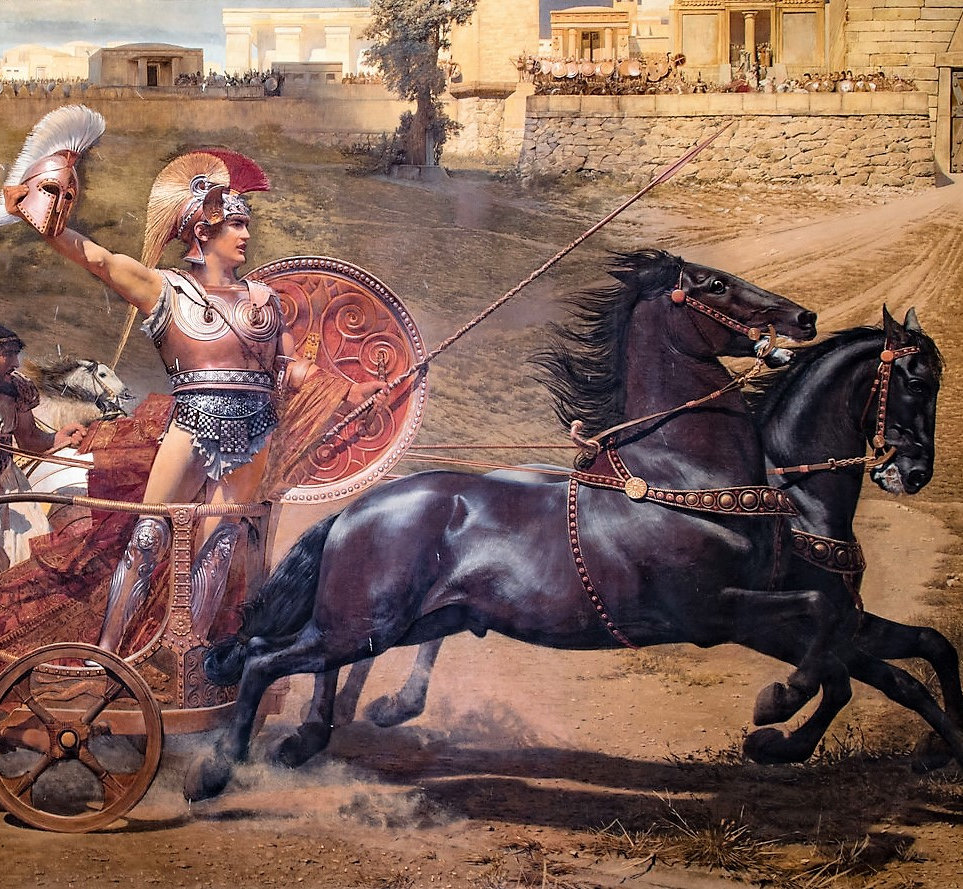Balius and Xanthus were, according to Greek mythology, two immortal horses, the offspring of the harpy Podarge and the West wind, Zephyrus. Book 16 of the Iliad tells us that Achilles had a third horse, Pedasos (maybe “Jumper”, maybe “Captive”), which was yoked as a trace horse, along with Xanthus and Balios. Achilles had captured Pedasos when he took the city of Eetion. Pedasos was mortal, but he could keep up with the divine horses. Sarpedon, prince of Lycia and ally of Troy, killed Pedasos when his spear missed Patroclus. Achilles’ comrade-in-arms Patroclus used to feed and groom these horses. In the Iliad, it was told how, when Patroclus was killed in battle, Xanthus and Balius stood motionless on the field of battle and wept. At Iliad 17.474-8, Automedon, Achilles’ charioteer, states that only Patroclus was able to fully control these horses. When Xanthus was rebuked by the grieving Achilles for allowing Patroclus to be slain, Hera granted Xanthus human speech allowing the horse to say that a god had killed Patroclus and that a god would soon kill Achilles too. After this, the Erinyes struck the horse dumb.
| Alias Xanthos |
| Real Names/Alt Names Xanthos |
| Characteristics Myths & Legends, Horse, Bronze Age |
| Creators/Key Contributors Homer |
| First Appearance Greek mythology |
| First Publisher ○ |
| Appearance List Literature: Homer’s Odyssey (c. 8th century BCE, English 1614), Homer’s Iliad (c. 8th century BC), Virgil’s Aeneid (29 to 19 BC), 5th century plays by Aeschylus, Sophocles (Ajax, Philoctetes), and Euripides (Hecuba, Rhesus, Cyclops), Plato’s Hippias Minor, Shakespeare’s Troilus and Cressida (1602), Dante Alighieri’s Divine Comedy (1308–1320), Lord Tennyson’s “Ulysses” (1842), The Story of Greece: Told to Boys and Girls by Mary Macgregor (191-?) [Internet Archive], Frederick Rolfe’s The Weird of the Wanderer (1912), James Joyce’s Ulysses (1918–1920), Nikos Kazantzakis’ The Odyssey: A Modern Sequel (1938), Eyvind Johnson’s Return to Ithaca (1946), The Luck of Troy (1961), et. al. Film: The Mysterious Island (1905), L’Odissea (1911), Ulysses (1954), Ulysses (1955), The Trojan Horse (1961), The Fury of Achilles (1962), Ulysses Against the Son of Hercules (1962), The Lion of Thebes (1964), et. al. Comics: Blue Bolt vol. 2 #1-2, Treasure Chest vol. 14 #5. |
| Sample Read The Iliad (Translated by W. C. Bryant, August, 1869) [Standard eBooks] |
| Description Balius and Xanthus were, according to Greek mythology, two immortal horses, the offspring of the harpy Podarge and the West wind, Zephyrus. Book 16 of the Iliad tells us that Achilles had a third horse, Pedasos (maybe “Jumper”, maybe “Captive”), which was yoked as a trace horse, along with Xanthus and Balios. Achilles had captured Pedasos when he took the city of Eetion. Pedasos was mortal, but he could keep up with the divine horses. Sarpedon, prince of Lycia and ally of Troy, killed Pedasos when his spear missed Patroclus. Achilles’ comrade-in-arms Patroclus used to feed and groom these horses. In the Iliad, it was told how, when Patroclus was killed in battle, Xanthus and Balius stood motionless on the field of battle and wept. At Iliad 17.474-8, Automedon, Achilles’ charioteer, states that only Patroclus was able to fully control these horses. When Xanthus was rebuked by the grieving Achilles for allowing Patroclus to be slain, Hera granted Xanthus human speech allowing the horse to say that a god had killed Patroclus and that a god would soon kill Achilles too. After this, the Erinyes struck the horse dumb. |
| Source Balius and Xanthus – Wikipedia |

